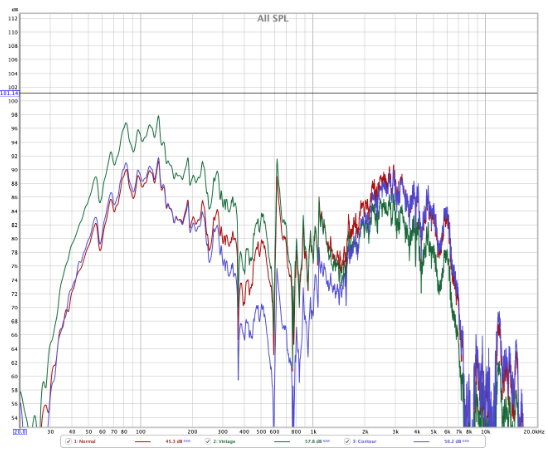my obsession with these girls is getting rather unhealthy. hah so do i. or rather, i did. until yesterday ![]()
Continuing to take this thread off topic, they were great live. Tons of energy, lots of fun.

Hahahaha awesome! I hope you love the body shape. I so badly wanted to love my Streamers but just didn’t.
Hey Whying, Take the specs with a grain of salt. I think that’s their -10dB bandwidth, and 10dB down is a lot. Having said that, I still really like their low end and there is nothing even close in their class. They even sound good with a 5-string, although you lose the fundamental. Yes - they share basically the same DSP and use the same app as the 710 and have a 5-band parametric EQ on each input plus an 8-band parametric on the output. It also has reverb, delay and chorus which is nice when you pop a mic on it.
The PRX710s are great speakers. They’re my first choice for stage monitors. Not too big but excellent sound and easy to carry!
Soulman is absolutely correct about how things will sound with your 5-string. It’s a place where I feel you can go wrong just buying something and trusting it will be good.
Pretty much every good amp & cab will handle a 4-string well. Very few systems are spec’d down to 32Hz (GR Bass has some, and they are very lightweight), and how a speaker handles frequencies below their cutoff will vary a lot based on the cabinet design. Luckily, even some of the big online vendors have excellent return policies, so the exposure for trying things out is mostly just time and hassle.
It also may be beneficial checking out a really good PA speaker and using an amp modeler as discussed elsewhere. But I think my MarkBass 4x10 weighs less than most PAs and the GRBass head unit is just tiny.
Thanks! That’s really good advice.
I would be completely unconcerned with a stated bass -10dB rolloff at ~40Hz. Honestly anything there or lower is contributing to muddy sounding garbage in the mix anyway and your ears are primarily hearing higher harmonics of tones that low to begin with. And even more, most bass cabs start rollling off in the ~40Hz range for good ones (and higher for most combo practice amps).
The “cutoff” is not a hard line or a cliff, it’s simply where the natural rolloff on the low end has hit an arbitrary value (usually -6dB or -10dB SPL, depending on manufacturer).
Ears trump specs in these cases. You really need to listen to the cabs live. If you must trust specs, instead it is much better to track down the actual frequency response graph rather than rely on the manufacturer numbers.
As long as it is just a rolloff Howard. And the modern JBLs (and most others, but not all) do just that and sound fine. That’s mostly because the DSP is making sure the cabinet isn’t dealing with frequencies it can’t handle. But ported cab designs, which virtually all new designs are, can have severe problems near and below their tuning frequency. There are lots of tradeoffs around size and shape of the ports, interior materials, transducer response, etc. A combo or powered speaker will usually have filters to ensure rolloff before bad things happen, but a passive cab may or may not have those filters. So one other point - when you play test, play at a variety of volumes. What sounds good when quiet might be less appealing at high volume when those transducers are bashing back and forth to their limits and chuffing the air through undersized ports.
More modern amps/cabs often have a pronounced fundamental and can be surprisingly flat down there. But most of the classics have truly lousy response at 40Hz. My B15 (which is not ported) is very peaky at 80Hz and the “big bass” switch just enhances that peak - it does virtually nothing down lower. The adage is that you feel the fundamental of the bass and hear the second harmonic. It’s why the EON Compact sounds good (to me) on a low B. It’s also why you could get away with less than 100W of power back then (Only 25W for the B15 original!) but 300W isn’t enough now. All that power went to frequencies you can hear, not just pushing air.
I think we need to be precise in terminology here.
The speaker will have a frequency response that rolls off smoothly at either extreme and has peaks at various frequencies in the spectrum, most notably the speaker’s resonant frequency.
The cabinet or enclosure will have audio properties as well and in particular a specific resonant frequency that will influence the tone.
There also may be electronics in the cabinet - passive or active filters (hi/lowpass/shelf or crossover) or eq (same thing really but bandpass) depending on model. These can impose a more steep cutoff (usually -6, -12, or -24d/octave). These are really common in monitors, TBH I don’t know enough cabs well enough to say.
I would have written exactly this.
So I now need to look at 2x12 cabs. Got it. Will keep you updated
I glanced once and it seems like there are lots of good options in that price range. Darkglass and Aguilar stuff that also sounded really good on YouTube stuck out for me in addition to the ampeg venture offerings.
So I now need to look at 2x12 cabs. Got it. Will keep you updated
If you are leaving the house I still like the strategy of two individual 12” cabinets where you can take one if traveling lighter.
two individual 12” cabinets
Yeah and it could be interesting to build those 1x12" cabs using the famous Thiele TL806 design. Compact and quite easy to build, especially for a carpenter like @Barney obviously.
One more factor to consider is the amp you’ll be using and the volume you plan to play at. While some cabs even as small as my Bass Array 110 will handle a 5 string adequately at home or rehearsal volume I would not even think about using it alone on a full volume gig with an entire band. IMHO you can never have “too much” speaker capability. It’s always best to have a bit more power and speaker area than too little which may cause you to drive an amp or speakers beyond their limits.
Yeah and it could be interesting to build those 1x12" cabs using the famous Thiele TL806 design. Compact and quite easy to build, especially for a carpenter like @Barney obviously.
(@terb knows all of this but I want to quote his cab link as this is a great illustration)
That’s an awesome example of what both @CardinalFlyer and I were getting at above. In this case it’s a case of the enclosure/cabinet limiting max SPL at low frequencies. It has a non-ported mode which exhibits a pretty smooth rolloff starting at about 200Hz and giving a -5-6dB/octave rolloff down to about 50-55Hz, where it is at about -10dB (or half the apparent volume response) which they are calling its lower limit. After that the rolloff steepens a bit so that’s a useful value. It also has a ported mode that stays flatter longer but rolls off steeper to a higher low end limit frequency.
No matter what speaker or how much power you put in to that thing, it’s going to have a low end response down to around 50Hz, which is right around the lowest G on a 4-string. Low E is 10Hz lower.
Is this a problem? Not at all. I think a 4 or even 5 string would sound awesome with this cabinet. The fact of the matter is, for frequencies that low, our ears hear mostly higher harmonics. The net effect of that lower limit is to reduce stuff that will just muddy the mix anyway. I like this cab’s response.
For those of you with a Rumble 100, do you like the way your amp sounds? If so then you would probably love this cab, because the Rumble 100 has rolled off roughly the same at 50Hz as this cab would:

(That massive mids scoop, so very Fender ![]() )
)
That massive mids scoop, so very Fende
That’s why I love my JBL EON710 … it’s quite linear…
This is my own measurement with REW and miniDSP UMIK-1 mic (that’s before correction with DSP/EQ):
After EQ correction it was even better … could not find the measurement graph, sorry!
Cool. Roughly the same low end rolloff, you’re at around -10dB at ~45Hz there. Second fret on the E string ![]()
BTW that Fender scoop is intentional, they do it on purpose. It’s their historical sound.
Fender scoop is intentional, they do it on purpose
That’s exactly my issue with non-FRFR and non-PA speakers: they have their own character/tone.
I understand that this is wanted for some use cases, but for my use case (using cab sims), a speaker with it’s own tone world be counter productive.
You can never get a proper cab simulated tone, if the speaker has it’s own tone already. And I cannot listen properly to my mix cleanly, if a speaker is optimized for bass (only).
So I’m always looking for something, neutral, responsive and with a wide frequence range…

